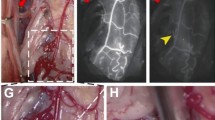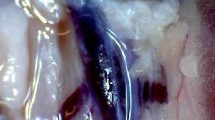Abstract
Vascular anomalies are most commonly seen in the head and neck region, and there is no animal model available of this disease until now. The purpose of this study was to construct a conditional murine polyomavirus middle T antigen gene (PyMT) transgenic mice model, in order to provide a basis for the treatment of vascular anomalies in vivo, as well as the study of PyMT’s molecular function. A new conditional transgenic vector based on Tet-On system was constructed successfully. After the experiment in vitro, pronuclear microinjection method was used to introduce the purified transgene into the chromosomes of fertilized mice eggs, and five transgenic positive mice were obtained. The transgenic positive animals went down to future generation by hybridization. After induction of PyMT’s expression in the F1 generation, three transgenic mice developed venous malformation which was confirmed histopathologically. The mice model generated could be used as a tool to study venous malformation, as well as the function of PyMT gene.





Similar content being viewed by others
References
Backman CM, Zhang Y, Hoffer BJ, Tomac AC (2004) Tetracycline-inducible expression systems for the generation of transgenic animals: a comparison of various inducible systems carried in a single vector. J Neurosci Methods 139:257–262. doi:10.1016/j.jneumeth.2004.05.012
Boeda B, Weil D, Petit C (2001) A specific promoter of the sensory cells of the inner ear defined by transgenesis. Hum Mol Genet 10:1581–1589. doi:10.1093/hmg/10.15.1581
Burgess-Beusse B, Farrell C, Gaszner M, Litt M, Mutskov V, Recillas-Targa F, Simpson M, West A, Felsenfeld G (2002) The insulation of genes from external enhancers and silencing chromatin. Proc Natl Acad Sci USA 99(Suppl 4):16433–16437. doi:10.1073/pnas.162342499
Cerutti H, Johnson AM, Gillham NW, Boynton JE (1997) Epigenetic silencing of a foreign gene in nuclear transformants of Chlamydomonas. Plant Cell 9:925–945. doi:10.1105/tpc.9.6.925
Finnegan EJ, Genger RK, Peacock WJ, Dennis ES (1998) DNA methylation in plants. Annu Rev Plant Physiol Plant Mol Biol 49:223–247. doi:10.1146/annurev.arplant.49.1.223
Gossen M, Bujard H (1992) Tight control of gene expression in mammalian cells by tetracycline-responsive promoters. Proc Natl Acad Sci USA 89:5547–5551. doi:10.1073/pnas.89.12.5547
Gossen M, Freundlieb S, Bender G, Muller G, Hillen W, Bujard H (1995) Transcriptional activation by tetracycline in mammalian cells. Science 268:1766–1769. doi:10.1126/science.7792603
Ingelbrecht I, Van Houdt H, Van Montagu M, Depicker A (1994) Posttranscriptional silencing of reporter transgenes in tobacco correlates with DNA methylation. Proc Natl Acad Sci USA 91:10502–10506. doi:10.1073/pnas.91.22.10502
Lottmann H, Vanselow J, Hessabi B, Walther R (2001) The Tet-On system in transgenic mice: inhibition of the mouse pdx-1 gene activity by antisense RNA expression in pancreatic beta-cells. J Mol Med 79:321–328. doi:10.1007/s001090100229
Mizuguchi H, Xu ZL, Sakurai F, Mayumi T, Hayakawa T (2003) Tight positive regulation of transgene expression by a single adenovirus vector containing the rtTA and tTS expression cassettes in separate genome regions. Hum Gene Ther 14:1265–1277. doi:10.1089/104303403767740803
Mulliken JB, Glowacki J (1982) Hemangiomas and vascular malformations in infants and children: classification based on endothelial characteristics. Plast Reconstr Surg 69:412–423
Primo L, Roca C, Ferrandi C, Lanfrancone L, Bussolino F (2000) Human endothelial cells expressing polyoma middle T induce tumors. Oncogene 19:3632–3641. doi:10.1038/sj.onc.1203708
Qu Z, Thottassery JV, Van Ginkel S, Manuvakhova M, Westbrook L, Roland-Lazenby C, Hays S, Kern FG (2004) Homogeneity and long-term stability of tetracycline-regulated gene expression with low basal activity by using the rtTA2S-M2 transactivator and insulator-flanked reporter vectors. Gene 327:61–73. doi:10.1016/j.gene.2003.10.029
Rivella S, Callegari JA, May C, Tan CW, Sadelain M (2000) The cHS4 insulator increases the probability of retroviral expression at random chromosomal integration sites. J Virol 74:4679–4687. doi:10.1128/JVI.74.10.4679-4687.2000
Taboit-Dameron F, Malassagne B, Viglietta C, Puissant C, Leroux-Coyau M, Chereau C, Attal J, Weill B, Houdebine LM (1999) Association of the 5′HS4 sequence of the chicken beta-globin locus control region with human EF1 alpha gene promoter induces ubiquitous and high expression of human CD55 and CD59 cDNAs in transgenic rabbits. Transgenic Res 8:223–235. doi:10.1023/A:1008919925303
Vitale-Cross L, Amornphimoltham P, Fisher G, Molinolo AA, Gutkind JS (2004) Conditional expression of K-ras in an epithelial compartment that includes the stem cells is sufficient to promote squamous cell carcinogenesis. Cancer Res 64:8804–8807. doi:10.1158/0008-5472.CAN-04-2623
Williams RL, Courtneidge SA, Wagner EF (1988) Embryonic lethalities, and endothelial tumors in chimeric mice expressing polyoma virus middle T oncogene. Cell 52:121–131. doi:10.1016/0092-8674(88)90536-3
Zabala M, Wang L, Hernandez-Alcoceba R, Hillen W, Qian C, Prieto J, Kramer MG (2004) Optimization of the Tet-On system to regulate interleukin 12 expression in the liver for the treatment of hepatic tumors. Cancer Res 64:2799–2804. doi:10.1158/0008-5472.CAN-03-3061
Zhu Z, Ma B, Homer RJ, Zheng T, Elias JA (2001) Use of the tetracycline-controlled transcriptional silencer (tTS) to eliminate transgene leak in inducible over-expression transgenic mice. J Biol Chem 276:25222–25229. doi:10.1074/jbc.M101512200
Acknowledgement
This work was supported by National Natural Science Foundation of China (Grant No. 30371546).
Author information
Authors and Affiliations
Corresponding author
Rights and permissions
About this article
Cite this article
Wang, Y.A., Zheng, J.W., Fei, Z.L. et al. A novel transgenic mice model for venous malformation. Transgenic Res 18, 193–201 (2009). https://doi.org/10.1007/s11248-008-9224-1
Received:
Accepted:
Published:
Issue Date:
DOI: https://doi.org/10.1007/s11248-008-9224-1




